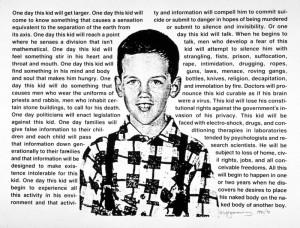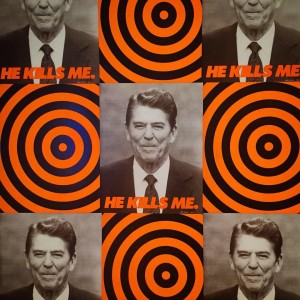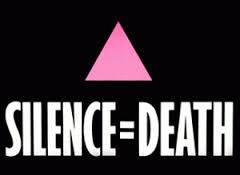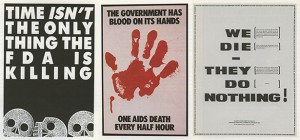 The high cost of specialty drugs, opaque information on risks of many existing prescription drugs, and lack of cures for diseases impacting millions of people are forces driving patients into activism, the likes of which we haven’t seen since the emergence of AIDS.
The high cost of specialty drugs, opaque information on risks of many existing prescription drugs, and lack of cures for diseases impacting millions of people are forces driving patients into activism, the likes of which we haven’t seen since the emergence of AIDS.
I was reminded this yesterday, not inside the Beltway at an FDA or Congressional hearing, or in an online social network of patient activists.
I was visiting the newly re-opened and re-built Whitney Museum, an architectural gem now re-energizing the Meatpacking District in Lower Manhattan.
It wasn’t the building design (which is getting rave reviews from architecture critics) that turned my mind toward a déjà vu on health politics, but in the Neil Bluhm Family Galleries on the 5th floor which features artworks created during the AIDS crisis beginning in the early 1980s.
 There is the iconic photograph of Robert Mapplethorpe, one of the great portrait photographers of his time who died too young, pictured here with his skull-sceptre. There is David Wojnarowicz’s One Day This Kid Will… moving autobiographical portrait and words, especially poignant because he died in 1992. And there’s the piece that resonated most with me as I wrestle with current health politics, the cost of Hep C meds, and the lack of cures for conditions close family and friends are dealing with: Alzheimer’s, paralysis, multiple myeloma, among others.
There is the iconic photograph of Robert Mapplethorpe, one of the great portrait photographers of his time who died too young, pictured here with his skull-sceptre. There is David Wojnarowicz’s One Day This Kid Will… moving autobiographical portrait and words, especially poignant because he died in 1992. And there’s the piece that resonated most with me as I wrestle with current health politics, the cost of Hep C meds, and the lack of cures for conditions close family and friends are dealing with: Alzheimer’s, paralysis, multiple myeloma, among others.
 He Kills Me is Donald Moffett’s indictment of AIDS and public health during the Reagan Presidency. This image speaks to Moffett’s (correct) view that the Federal government was avoiding and denying the presence of a new-new virus, turning away from a public health crisis that was killing young men in the prime of their lives, and not funding research that could have helped to stem the dying sooner.
He Kills Me is Donald Moffett’s indictment of AIDS and public health during the Reagan Presidency. This image speaks to Moffett’s (correct) view that the Federal government was avoiding and denying the presence of a new-new virus, turning away from a public health crisis that was killing young men in the prime of their lives, and not funding research that could have helped to stem the dying sooner.
Here’s a brief timeline, thanks to AIDS.gov, part of the U.S. Centers for Disease Control (CDC):
- On June 5 1981, the CDC published a Morbidity and Mortality Weekly Report describing cases of a rare lung infection, Pneumocystis carinii pneumonia (PCP) in five young, previously healthy gay men in Los Angeles. By the time the report was published, two had already died. Within days of the report’s publication, the CDC receives countless reports of similar cases from around the country.
- On April 13, 1982, U.S. Representative Henry Waxman convened the first congressional hearings on HIV/AIDS.
- On September 17, 1985, over four years after the initial CDC report, President Ronald Reagan said the acronym “AIDS” in public for the first time.
- In 1986, the National Academy of Sciences issued a report critical of the U.S. response to a “national health crisis.” The report called for a $2 billion investment. An IOM report called for a national education campaign and sought to create a National Commission on AIDS.
The Whitney’s discussion of David W.’s self-portrait succinctly explains how art can explain politics better than any politician’s speech – art as an instrument of protest and a vehicle for enlightenment.
Health Populi’s Hot Points: I lost my dear friend Tony the year that Donald Moffett painted He Kills Me. Indeed, a part of me died when Tony died: he succumbed to AIDS so very quickly, and the end was very, very difficult.
 ACT-UP was born in New York City in 1987 as the AIDS Coalition to Unleash Power. The founders and early members demonstrated in the NYC financial district near Wall Street in March that year to, in the words of ACT-UP, “protest the profiteering of the pharmaceutical companies,” namely, Burroughs-Wellcome (now absorbed into GSK), the maker of AZT — the first promising drug for HIV/AIDS.
ACT-UP was born in New York City in 1987 as the AIDS Coalition to Unleash Power. The founders and early members demonstrated in the NYC financial district near Wall Street in March that year to, in the words of ACT-UP, “protest the profiteering of the pharmaceutical companies,” namely, Burroughs-Wellcome (now absorbed into GSK), the maker of AZT — the first promising drug for HIV/AIDS.
The ACT-UP poster asserting that “Time isn’t the only thing the FDA is killing” resonates with people — patients, caregivers, loving friends of sick people — today, over a quarter-century after ACT-UP’s Wall Street protests. That was an early sentinel sign of an Occupy movement, discussed here in The Atlantic.
Art in its many forms — “fine,” street, and performance — makes manifest social movements. I expect we will witness more art expressed in the interest of health, individual and public, over the coming months and years focusing on health care costs, access, quality, and equity. My friend and colleague Regina Holliday is one such artist who is spawning such an artistic movement focused on patients’ rights to their health data.
 For a crystal-clear appreciation of AIDS politics in the Reagan era, must-reading is And the Band Played On by Randy Shilts. For a moving portrayal of life during and after the first generation of AIDS. then HIV as a chronic condition, see or read The Normal Heart by Larry Kramer.
For a crystal-clear appreciation of AIDS politics in the Reagan era, must-reading is And the Band Played On by Randy Shilts. For a moving portrayal of life during and after the first generation of AIDS. then HIV as a chronic condition, see or read The Normal Heart by Larry Kramer.






 I'm in amazing company here with other #digitalhealth innovators, thinkers and doers. Thank you to Cristian Cortez Fernandez and Zallud for this recognition; I'm grateful.
I'm in amazing company here with other #digitalhealth innovators, thinkers and doers. Thank you to Cristian Cortez Fernandez and Zallud for this recognition; I'm grateful. Jane was named as a member of the AHIP 2024 Advisory Board, joining some valued colleagues to prepare for the challenges and opportunities facing health plans, systems, and other industry stakeholders.
Jane was named as a member of the AHIP 2024 Advisory Board, joining some valued colleagues to prepare for the challenges and opportunities facing health plans, systems, and other industry stakeholders.  Join Jane at AHIP's annual meeting in Las Vegas: I'll be speaking, moderating a panel, and providing thought leadership on health consumers and bolstering equity, empowerment, and self-care.
Join Jane at AHIP's annual meeting in Las Vegas: I'll be speaking, moderating a panel, and providing thought leadership on health consumers and bolstering equity, empowerment, and self-care.